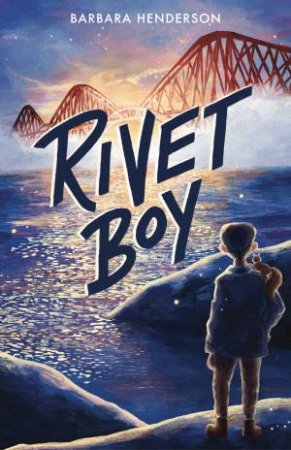Rivet boy by Barbara Henderson

Inverness- based author Barbara Henderson is a winning author of the Historical Association's Young Quills Award for the best children's historical fiction. Rivet Boy (first published {in Australia} by Affirm Press, 2025) follows in this pattern of excellent historical fiction for children. Rivet Boy blends fact and fiction to tell the story of a very likeable and courageous 12-year-old boy called John Nicol who finds himself breadwinner of his family (on the death of his father who was struck by a rivet) and who therefore has to find dangerous employment on the Forth Bridge construction site. In the Author's Note we find that John Nicol did truly exist and that he did survive a fall from the bridge. Of the men and boys who died constructing this bridge 57 were officially recorded but later research has identified at least 73. Some fell; some may have been pushed. Work safety practices in the 1880s were basic. John had to conquer his fear of heights and bullying, bad men (especially his boss, Cain Murdoch and his henchmen sons) to work at a job as a rivet boy handling the over six million boiling hot metal rivets required to hold the structure together.
John makes two new friends- a girl called Cora and a squirrel that he names Rusty. Their faithfulness, help and friendship provide a softness that counterbalances the privations, danger and terror that is John's lot. There are cliff hangers that lead to the turning point that will make the reader gasp..." I glance up at the bridge and bite my lip."There's an ill wind blowing..." " And this is where I made my mistake..."
In the manner of all good historical fiction, Henderson has woven real historical characters into an historical event - the building and opening of the Forth Bridge - the historic cantilever bridge in Scotland that spans the Firth of Forth. Cleverly Henderson uses the device of the newly invented autograph book for John to collect the names of important people of the times to weave them into the storyline. Indeed as Henderson found in her research, famous people did visit the site including the Crown Prince and Lady Moir, founder of the Society of Women Engineers. Mr Peebles, a kindly and instrumental guide and friend to John was indeed the real librarian at the newly opened Carnegie Library.
The Scottish language permeates the story filling it with wise sayings that bolster John in times of trouble. Each chapter heading reveals the character, ethics and strength of the Scottish thinking of the time. These include:"Beggars cannae be choosers, Luck favours the brave, Don't look a gift horse in the mouth, Luck is loaned, not owned, Nothing ventured, nothing gained, Time and tide will tarry for no man etal..." There is so much quiet wisdom in this book.
Young readers will be inspired by a story that is steeped in historical research that can show them something of the hardship, courage and resilience required of children of the same age as them living in Victorian Scotland where there was no social security net for struggling families, where children had to work and the right to schooling was not assumed.
For children studying Design and Technology at school, bridge building and engineering history is an interesting topic. Rivet Boy with its blending of plot with detailed descriptions of the process and construction of the bridge (especially the cantilever style) and the use of rivets is a fascinating and applicable, real-life read that would provoke interest in this area of the curriculum perhaps in children who wouldn't previously have shown any interest in STEM subjects such as engineering, design or technology.
Rivet Boy is an engaging, warm, historical adventure rooted in real events that brings us a character from history (John Nicol) who is an inspiring role model. This book, through its insights into Victorian child labour, engineering history and the societal shifts of the era, is of useful educational value for young readers.
Themes: Bridge building- Forth Bridge Scotland, Victorian child labour, Bullying, Victorian Scotland, Engineering history, Overcoming fear, Friendship.
Wendy Jeffrey